#taijiswordfencing
Photo
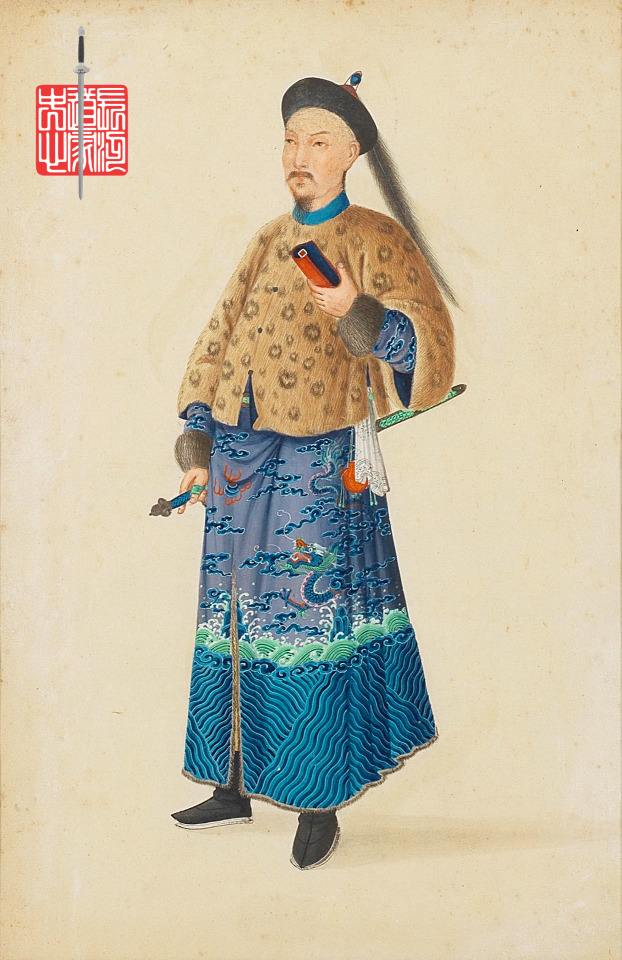
A High Qing Officer
Armed with a Jian. The vast majority of Manchu Bannermen carried dao, so it is quite unusual to see an official armed in this fashion.We know he is a Bannerman by the green jade thumb around his right thumb.Thumb rings were worn as a symbol of their status as Qiren.
One might think that his man was left handed given that he is wearing his sword on his right hip. But the thumb ring on his right thumb indicated he was indeed right handed. Perhaps there were some social situations where those armed were required to wear their swords on the opposite hip to prevent a quick draw. If this is the case, I am unaware of such a tradition in China. My suggestion is pure speculation. It is also quite possible that the artist simple decided he liked this look better and the swords position on the right hip has nothing to do with how it was actual worn.
19th Century, Chinese School Painting.
#zhongguojianfa#jianfa#chineseswordsmanship#historicalswordsmanship#swordsmanship#chineseswordfighting#swordfighting#duanbing#chineseswordwork#swordwork#swords#chineseswordarts#daoistswordarts#swordarts#swordart#chineseswordart#taijiswordfencing#swordfighter#中國劍法#劍法#劍#kungfuweapons
37 notes
·
View notes
Text
Twilight Jianfa!
After training 3 days at Rodell Laoshi’s St. Paul Seminars, they wanted to test their sword skills. So out they went to the local plaza for some friendly bouting.
Seen on the left is Richard Son Su Meyer, director of Great River Taoist Center Twin Cities. And on the right is Quinatzin De La Torre. Both are long time students of Rodell Laoshi.
Note that both have years of experience in full contact swordplay and are able to control the power of their blows, even at full speed. Less experienced practitioners must don proper swordplay armor, particularly head and eye protection, when bouting.
#jianfa#chineseswordsmanship#jianshu#chineseswordfighting#chineseswordplay#chinesemartialarts#scottmrodell#duanbing#chinesemartialart#swordplay#taijijian#taichisword#yangjiamichuantaijijian#taijiswordfencing#chineseswordfencing#kungfuweapons#swordfightingclasses#swordfightingskills#swordfightingschool#daoistswordarts#daoistswordart#chinesesword#swordarts#swordfight#swordfighter#wudangsword#chineseswordwork#wudangjian#fullcontact#ukchineseswordfighting
11 notes
·
View notes
Text

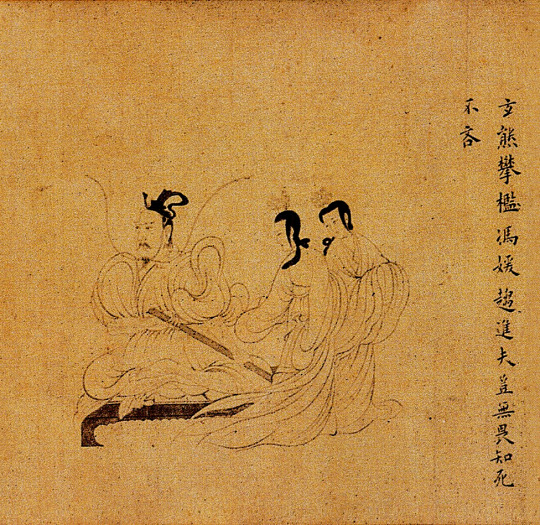

The history of the Chinese Fast Sword Draw (出劍法) dates back to the Han dynasty, 2,000 plus years ago. Unfortunately, there are no known manuals for these techniques and historically illustrations are rare. This depiction of a seated swordsman drawing his sword is from a scroll originally painted by Gu Kaizhi ( 顧愷之) in the 4th century. While Gu’s original version of this scroll, The Admonitions of the Instructress to the Court Ladies (女史箴圖) has not survived, later copies of this work have.
The two following later copies of this scroll date to the Tang (dated between the 6th and 8th century AD) and Song dynasties. As such they are likely the oldest known illustrations of a Chinese Swordsman Preforming the Fast Sword Draw (出劍法). They are also the only know depiction of a seated Chinese sword drawn know to date. Given the age of the two paintings, it is difficult to make out the finer details. What we can see is that seated swordsman’s grip is palm out with his fingers wrapping over the grip prepared to draw and strike downward. His rear hand is well back toward the rear of the scabbard, palm down.
A skeptic might understandable suggest that the seated figure is actually wielding a cudgel. Given the lack of visible detail, this would be an understandable suggestion. However, there is no reason for a wooden club to be gripped at the rear end just prior to swinging it. And given that what appears to be bear is just before the seated man, if it were some sort of cudgel and not a sword ready to be drawn, it is more likely he would be gripping it with two hands not holding the the rear end palm down.
Note: the Tang period example of The Admonitions of the Instructress to the Court Ladies is in the collection of the British Museum in London. The Song period (960-1279) example is the property of the Palace Museum in Beijing.
#出劍法#chineseswordsmanship#jianfa#chineseswordfighting#chineseswordplay#scottmrodell#chinesemartialarts#duanbing#chineseswordsman#chineseswordarts#daoistswordarts#swordfighting#chineseswordfencing#taijiswordfencing#swordfightingskills#kungfuweapons#iaido#scottrodell#testcutting#jianshu#chineseswordart#swordarts#swordsmanship#historicalswordsmanship#swordplay#chinesesword#chineseswords#daofa
6 notes
·
View notes
Photo
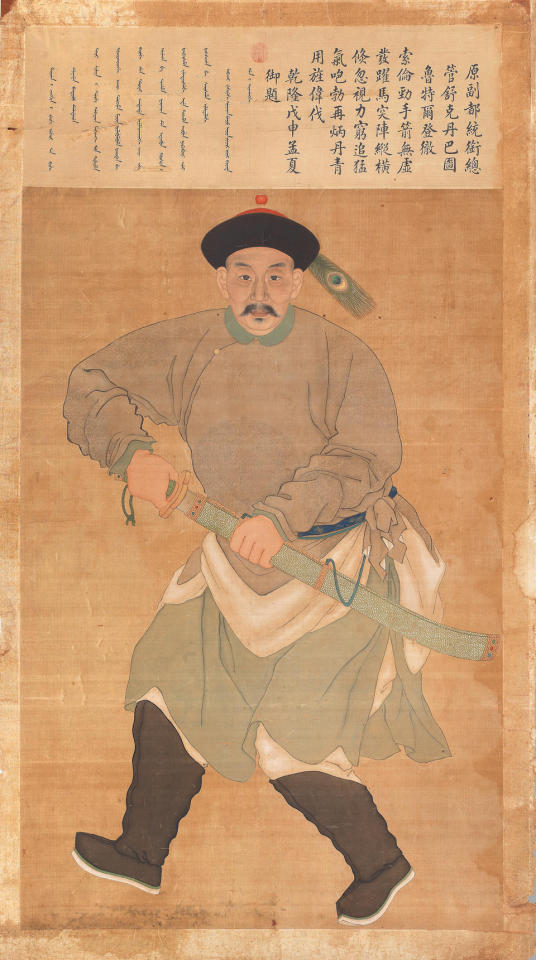

Bannerman Drawing his Saber
What is quite interesting about this painting is how the Sword Drawing technique it depicts is consistent with what we have seen before. Note for example, the position of the hand on the scabbard as he draws. It is not at the scabbard throat, but grasped midway along the suspension band. A detail seen in all other illustrations where a Dao (saber) is being draw. Also note that he is drawing with the edge down. Another apparently standard element of the Chinese Quick Sword Draw.
It is also refreshing to see just how Qing swordsmen dressed. Not in the flamboyant colors often worn by martial artists at tournaments today. But in muted grey, functional and not ostentatious.
For more about this painting of BANNERMAN TE'ER DENG CHE, see Bonham’s Auction Website-
https://www.bonhams.com/auction/27991/lot/128/a-rare-and-important-imperial-court-painting-of-the-bannerman-teer-deng-che-qianlong-dated-by-inscription-to-the-wushen-year-corresponding-to-1788-and-of-the-period/
And for a tutorial on Chinese Fast Sword Drawing, see my video on YouTube-
https://youtu.be/6AVk8PQjh2o
#chineseswordsmanship#chineseswordfighting#chineseswordplay#swordplay#chineseswordwork#swordwork#duanbing#swords#sword#daoistswordarts#chineseswordart#swordarts#swordart#taijiswordfencing#chinesemartialarts#chinesemartialart#swordfighter#swordtraining#swordfightingschool#swordfightingskills#中國刀法#刀法#kungfuweapons#出手法
9 notes
·
View notes
Text
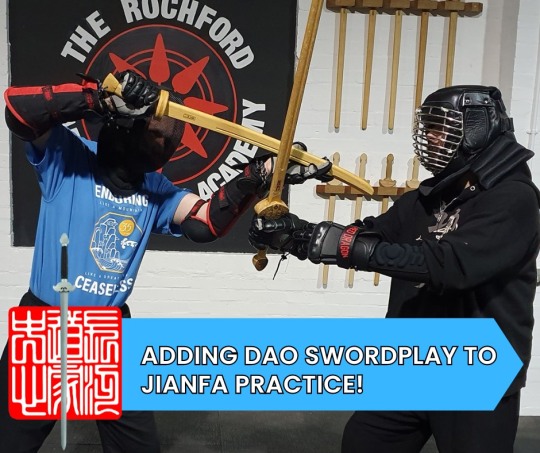
Merging Jianfa & Daofa in Your Swordplay:
Practitioners of Jianfa looking to explore the depths of Chinese swordsmanship, incorporating Daofa, the art of the saber, can add a more assertive, power orientated flavor to your swordplay.
This journey is not just a weapons switch up; it's about expanding your mindset, augmenting your skill set, while broadening your approach to swordsmanship.
In this guide, we'll navigate through the transition, focusing on practical techniques and insights to enhance your martial arts skills.
The Jian, with its straight, double-edged blade, epitomizes precision, agility, and adaptability, demanding a level of finesse and fine movement.
In contrast, the Dao, featuring heavier cuts, is a single-edged blade, representing power and efficiency in combat.
Uniting Daofa with Jianfa involves more than learning to handle a different sword, it means embracing a different approach in swordplay.
The Dao's point of balance is more forward than the Jian’s. This provides for more powerful cuts and thus a significant shift in technique. Daofa focuses not on the quick, wrist-led maneuvers that are the essence of Jianfa, instead focusing on powerful, elbow-driven techniques.
This style engages larger muscle groups for stronger and more impactful strikes, a key aspect in effectively wielding the Dao.
Starting with Pi Cut from Stirring Deflection
Begin your transformation with a drill common to both Jianfa and Daofa, the Pi cut from a stirring deflection. This provides a familiar base while introducing Dao's unique handling characteristics.
Chan involves a binding or wrapping movement, where the blade circles the body. It's a deflecting technique where the flat of the blade is used to deflect an incoming cut on one side of the body and then continues the motion to circle the blade around the torso, behind the back. This allows for a follow-up cut from the opposite side.
Deflecting with a Chan movement, the empty hand moves inside the blade, close to the chest, and can be employed to momentarily control the opponent’s sword arm as one advances forward. Training this technique introduces practitioners to the closer, more direct combat style found in Daofa. In contrast, Jianfa's prefers maintaining a distance that provides space to maneuver.
After gaining familiarity with the Pi and Hua cuts, it's insightful to progress to the distinctively heavier Kan cut. The Kan is and unique to saber systems, not being present in Jianfa.
Following this, the Duo cut would be the next logical cut to add. While the Duo cut is also present in Jianfa, it’s not made use of as frequently when wielding the straight sword.Training Daofa’s use of the Duo reminds us of why we are evolving our swordplay, merging the mindsets of Jianfa and Daofa, mixing more aggressive and assertive actions into our sword work.
In practice, although the timing of the Duo cut may appear similar to its Jianfa counterpart, it requires a considerably larger window of opportunity, reflecting the bolder and more direct approach of Daofa.
This exploration into the Duo cut provides practitioners with a new perspective on the rhythm shift from the more measured Jianfa to the dynamic and forceful Daofa.
The Pi cut can be likened to the power needed to trim a leaf off a tree, the Kan cut to chopping a thick branch, and the Duo cut to the robust action of felling an entire tree or splitting a log. This progression not only illustrates the escalating power inherent in Daofa techniques but also underscores the distinct tactical mindset required for this style of swordplay.
The Gua cut, though mechanically akin to the Liao cut in Jianfa, takes on a unique role in Daofa. It focuses an aggressive sweeping action to proactively capture the line, reflecting Daofa's assertive and power-oriented nature of Dao swordplay.
Incorporating shield work, especially with durable circular cost effective riot shields, provides insight into how the Dao would have been wielded on the battlefield. This practice not only enhances sword skills but also offers a better understanding of strategic defense and offense in historical combat contexts.
You can use a rattan Tengpai, but these are a lot more costly than a riot shield, which are far cheaper and will hold up to virtually anything you can throw at it during swordplay.
These individual cut drills can be combined into dynamic semi-fixed sparring routines, crucial for experiencing the reactive and adaptive nature of Daofa and preparing for unpredictable combat situations.
Merging Jianfa to Daofa offers an opportunity to evolve your understanding of Chinese swordsmanship, introducing new techniques and strategic thinking. It also adds tactical options to your swordplay, making you less predictable. This journey, embraced with dedication and an open mind, not only enhances your swordplay skills but also enriches your overall approach to swordsmanship. Enjoy the growth and mastery that come with learning the powerful art of the Daofa.
—----
All of the drills and cuts discussed in this guide can be found in the Daofa sections of the Academy of Chinese Swordsmanships Online Archives. Available to all members of the Daofa and Sword Scholars Study paths.
Visit www.chineseswordacademy.com for more details.
#chineseswordsmanship#jianfa#duanbing#chinesemartialarts#chineseswordplay#chineseswordfighting#scottmrodell#jianshu#daofa#scottrodell#daoistswordarts#chineseswordarts#swordfightingclasses#ukchineseswordfighting#taijijian#taijiswordfencing#taijisword#wudangsword#wudangjian#taijidao#taijisaber#swordfightingschool#kungfuweapons#swordfightingskills#chineseswordwork#swordtraining#劍法#刀法#chinesesword#yangjiamichuantaijijian
6 notes
·
View notes
Text
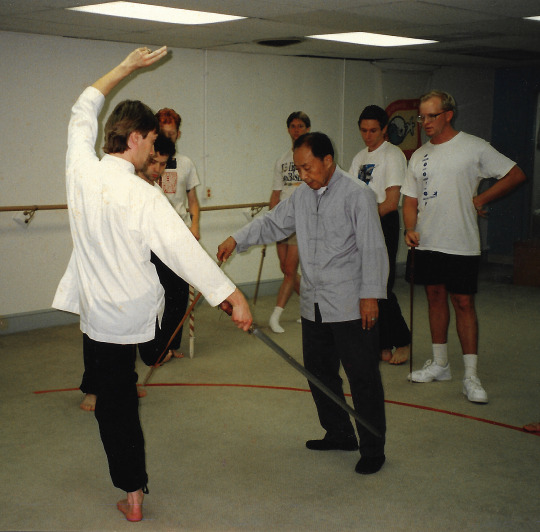
Wang Yen-nien schooling Scott M. Rodell on the finer points of the Yangjia Michuan Taiji Sword Form (楊家秘傳太極劍).
This Sword Form lies at the core of our Sword Work at the Academy of Chinese Swordsmanship.
We also draw upon the Ming period Two-Handed Dandao, the Four Roads Miaodao, the Yang Style Taiji Sword and Saber, and the WW2 Dadao.
#楊家秘傳太極劍#jianfa#chinesemartialarts#duanbing#chineseswordfighting#chineseswordsmanship#jianshu#scottmrodell#chineseswordplay#太極劍#swordclasses#scottrodell#wangyennien#chineseswordarts#chineseswordwork#ukchineseswordfighting#taijiswordfencing#taijisword#swordtraining#劍術#taijijian#chinesesword#chineseswordsman#yangstyletaichi#kungfuweapons#daoistsword#daoistswordsman#swordarts#historicalswordsmanship#swordfightingschool
3 notes
·
View notes
Text

We Need Your Input!
Hey everyone! We're reaching out to our current and potential students about Chinese swordsmanship. We want to make our classes and resources better for you.
What's Stopping You?
What are the main obstacles or issues you're facing in learning Chinese swordsmanship? Is it finding time, understanding the techniques, or something else? Let us know in the comments.
Your Feedback Matters
Your feedback is crucial. It helps us understand what you need and how we can improve. So, please, take a moment to tell us about your challenges.
Join the Conversation
If you haven't joined us yet, this is your chance to be part of a community that's all about learning and growing in Chinese swordsmanship. We're here to help each other. Join the Practical Chinese Swordsmanship Facebook group: https://www.facebook.com/groups/chineseswordacademy
Thanks for helping us make the Academy of Chinese Swordsmanship the best place to learn and practice this art.
#chineseswordfighting#chineseswordsmanship#jianfa#duanbing#chinesemartialarts#chineseswordplay#jianshu#scottmrodell#chinesemartialart#chineseswordarts#daoistswordarts#daoistswordsman#swordfightingschool#swordfightingskills#swordfightingclasses#scottrodell#ukchineseswordfighting#chineseswordwork#taijijian#taijiswordfencing#taijisword#taichisword#wudangsword#wudangjian#楊家秘傳太極劍#kungfuweapons#yangstyletaichichuan#yangstyletaichi#太極劍#taijifencing
2 notes
·
View notes
Text
? SWORD Geek ?
Then You Are Going to Love Chinese Sword Fighting!
Unlock the power of Chinese Swordsmanship on a practical and thrilling level. Our online training encapsulates full-contact, realistic swordplay, honing not just your technique and skill but your understanding of this ancient battlefield art tailored for the modern martial journey.
Dive into a Realm Where Steel Meets Skill
Our comprehensive program is designed to cater to both novices and seasoned sword practitioners. Here’s what’s awaiting you:
Attend live weekly webinars, fostering direct engagement, and dynamic feedback.
Dive deep into hundreds of hours of recorded webinars. Learn, revisit, and refine your techniques at your convenience.
Pursue a curriculum forged through ages, battle-tested, and refined for a focused and ever-evolving martial journey.
Embark on a 7-Day Free Trial
Join us today and take the first step towards mastering the ancient art of Chinese sword fighting!
Begin with a 7-day free trial, and continue confidently with our 30-day money-back guarantee.
Are You Ready to Unleash Your Inner Swordmaster?
This isn’t just a hobby, it’s a calling. It’s about honoring age-old traditions while forging new friendships. It’s where nerdy meets warrior. So why wait?
Join Today & Immerse Yourself in the World of Chinese Sword Fighting!
#jianfa#chineseswordsmanship#chineseswordfighting#chineseswordplay#chinesemartialarts#duanbing#scottmrodell#swordplay#chinesemartialart#zhongguojianfa#ukchineseswordfighting#chineseswordarts#daoistswordarts#taijiswordfencing#taijifencing#swordfightingclasses#swordfightingschool#劍法#楊家秘傳太極劍#yangjiamichuantaijijian
2 notes
·
View notes
Text
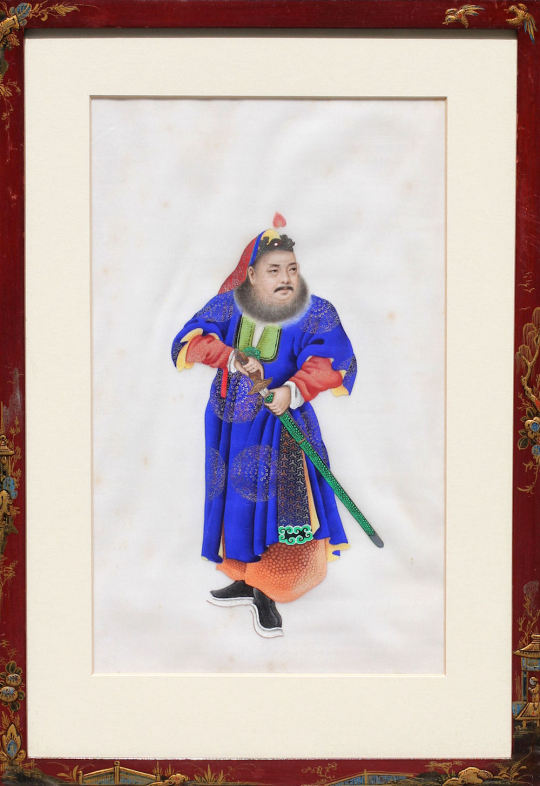
19th Pith Painting of a Jianke in Archaic Clothing
Drawing his Sword-
Another example of a Jianke (swordsman) drawing his jian. As we’ve seen in several other period images, his left hand is positioned at the throat of the scabbard as he draws for a downward cut. These pith paintings were produced in large numbers, this is not a page from a sword manual. So we should be cautious about drawing too many conclusions from it. It is interesting however to note that in multiple period images where a jian is being drawn, the left hand is showed at the top of the scabbard. Drawing of the dao are sometimes also depicted in this fashion, but more often with the left hand further down the scabbard at the suspension band.
I am also pleased to see the shape of the guard is quite similar to my Cutting Jian Hanwei forges.
#chineseswordsmanship#jianfa#chineseswordfighting#chineseswordplay#jianshu#chinesemartialarts#duanbing#chinesemartialart#zhongguojianfa#historicalswordsmanship#swordfightingschool#swordfightingskills#swordfightingclasses#swordfighting#chineseswordwork#swordwork#chineseswordarts#daoistswordarts#taijijian#taijiswordfencing#taijisword#taichisword#wudangjian#wudangsword#swordclasses#中國劍法#chinesefastdraw#劍法#swordfighter#太極劍
3 notes
·
View notes
Text

“In the midst of chaos, there is also opportunity”
INSTANT ACCESS. ANYWHERE. ANYTIME.
Sign up for our FREE 7 DAY TRIAL.
Find a study path that’s right for you..
#chineseswordsmanship#jianfa#chineseswordfighting#chineseswordplay#chinesemartialarts#scottmrodell#duanbing#jianshu#scottrodell#daoistswordarts#swordclasses#swordfightingschool#swordfighter#swordfightingskills#chineseswordarts#swordarts#taijijian#taijiswordfencing#taijisword#taichisword#chinesesword#chineseswordfencing#kungfuweapons#swordplay#yangjiamichuantaijijian#yangstylestaijiquan#yangstyletaichichuan#yangstyletaichi#ukchineseswordfighting#historicalswordsmanship
2 notes
·
View notes
Text
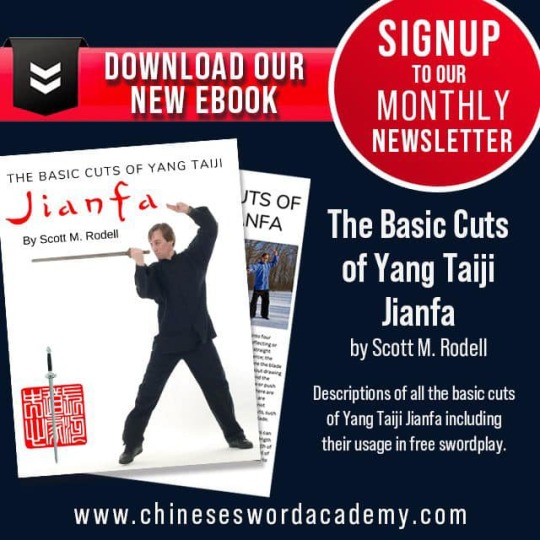
SIGNUP TO OUR MONTHLY NEWSLETTER
DOWNLOAD OUR NEW EBOOK HERE
https://www.chineseswordacademy.com/ebooksignup
The Basic Cuts of Yang Taiji Jianfa
by Scott M. Rodell
Descriptions of all the basic cuts of Yang Taiji Jianfa including their usage in free swordplay.
#chineseswordsmanship#jianfa#chineseswordfighting#chineseswordplay#scottmrodell#chinesemartialarts#duanbing#chinesemartialart#scottrodell#yangjiamichuantaijijian#taijiswordfencing#taijisword#taijijian#taichisword#yangstyle#yangstylestaijiquan#yangfamilytaijiquan#yangstyletaichichuan#chinesesword#chineseswordfencing#kungfuweapons#swordfighter#chineseswordwork#swordfightingskills#swordfightingschool#swordfightingclasses#swordclasses#swordclass#jianshu#daoistswordarts
2 notes
·
View notes
Text
FREE EBOOK COMING SOON
The Basic Cuts Of Yang Taiji Jianfa
By Scott M. Rodell
Available for free download Friday August 5.
Descriptions of all the basic cuts of Yang Taiji Jianfa including their usage in free swordplay.

Launching Friday!
#chineseswordsmanship#jianfa#chineseswordfighting#chineseswordplay#swordplay#scottmrodell#jianshu#duanbing#chinesemartialart#chinesemartialarts#scottrodell#taijijian#taijiswordfencing#taijisword#yangjiamichuantaijijian#yangshitaijijian#wudangsword#wudangjian#chineseswordwork#chinesesword#swordfightingclasses#swordfightingskills#swordclasses#chineseswordfencing#kungfuweapons#swordsmanship#daoistswordarts#daoistswordsman#chineseswordsman#chineseswordarts
2 notes
·
View notes
Text


A scroll titled Countries Figure (Kunigni Jinbutsukan) in the Kyoto National Museum depicts a Chinese Military Officer carrying a Jian. This work apparently dates to the early Ming period. What’s interesting about this image is that this military man is carrying his Jian in his left hand, rather than having it suspended from his belt. While this depiction of the sword carried in the hand rather than strapped to the belt is not new, it suggestions the idea that this depiction is not simply the standard artistic convention as the Japanese envoy who painted this was apparently recording what he saw.
Another element previously observed is that the Jian is grasped not close to the center of balance when it is sheathed, but close to the scabbard throat.
#chineseswordsmanship#jianfa#chineseswordfighting#chineseswordplay#jianshu#chinesemartialarts#duanbing#chinesemartialart#swordplay#chineseswordsman#chinesesword#taijiswordfencing#taijijian#taijisword#wudangsword#wudangjian#swordfighter#chineseswordwork#kungfuweapons#kungfu#mingdynasty#swordfightingskills
2 notes
·
View notes
Text
WANT TO LEARN CHINESE SWORDSMANSHIP?
INSTANT ACCESS. ANYWHERE. ANYTIME.
Sign up for our FREE 7 DAY TRIAL.
https://www.chineseswordacademy.com/membershipsandcourses
Find a study path that’s right for you.
Simply put, the Academy was born out of a desire to continue to move forward during these demanding times. Training at the Academy centers on developing practical, effective skills. To that end, Webinars concentrate on hand and footwork in the context of full contact swordplay tested cut combinations.
We don’t teach forms, we focus on tried and true application. Practitioners from a wide spectrums for traditions, Xingyiquan, Baimei, Wing Chun, Baguazhang, Taijiquan, Tanglangquan, and others, as well as non-Chinese traditions, train at the Academy. We look forward to training with you.
Founded in 1984, Great River Taoist Center is 35 years strong. Chinese Swordsmanship is not the latest fad for us, it is a three decade passion. Center director, Scott M. Rodell, is a well know leader in the rebirth of the art being the first practitioner to practice test cutting with Chinese swords since imperial times. Along side his years of experience in historical swordplay and training under acknowledged masters, Rodell has penned nine books on Chinese Martial Arts. These include several translations of classic sword manuals.
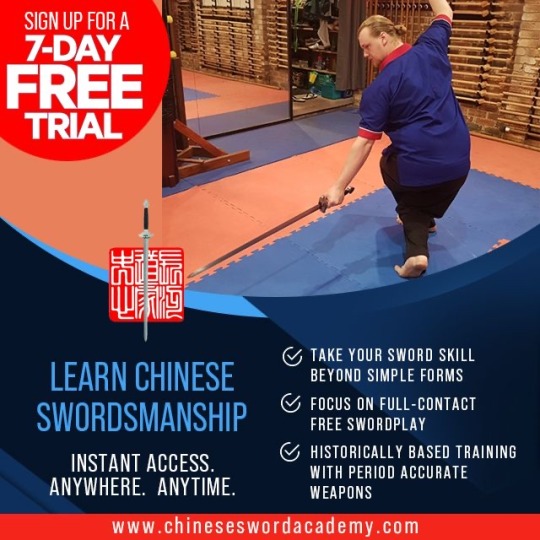
#jianfa#chineseswordsmanship#chineseswordfighting#jianshu#chineseswordplay#scottmrodell#duanbing#swordplay#chinesemartialart#chinesemartialarts#chineseswordwork#chineseswordsman#chinesesword#fullcontact#swordarts#taijiswordfencing#taijisword#taichisword#taijijian#yangjiamichuantaijijian#daofa#miaodao#chineselongsword#chineseswordfencing#daoistswordarts#daoistsword#wudangsword#wudangjian#kungfuweapons
5 notes
·
View notes
Photo

Slow, deliberate free swordplay, with contact, is an excellent, traditional method in Chinese Sword Work that helps both practitioners to see and understand the action and respond appropriately. First train fixed step to develop hand work, then moving. It's useful to train at a speed where neither can manage to land a blow. This also helps to develop a good flow and I find it quite enjoyable.
#zhongguojianfa#jianfa#scottrodell#scottmrodell#tallinn#swordsmanship#chineseswordsmanship#chineseswordplay#swordplay#taijiswordfencing#duanbing#historicalswordsmanship#chineseswordfighting#swordfighting#swordfightingschool#swordfightingskills#chineseswordwork#swordwork#swords#sword#daoistswordarts#chineseswordart#swordarts#swordart#chineseswordarts#yangjiamichuantaijijian#taijijian#taijisword#taichisword#wudangsword
2 notes
·
View notes
Photo
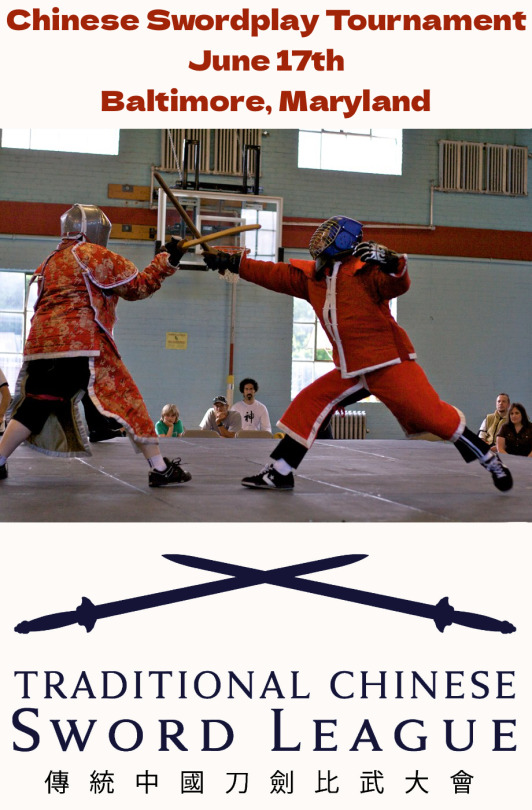
Heads Up, this Year's Full Contact Chinese Swordplay Tournament has been moved Forward 2 Weeks to Saturday, June 17th. There is also a change of Venue. The Tournament will be held in Baltimore and there will be a Seminar the day after. Details to follow shortly. In the meantime, mark your calendar, and TRAIN!
#zhongguojianfa#jianfa#chineseswordsmanship#historicalswordsmanship#swordsmanship#ukchineseswordfighting#chineseswordfighting#swordfighting#swordfightingskills#duanbing#chineseswordwork#swordwork#chineseswordarts#daositswordarts#swordarts#chineseswordart#swordart#taijijian#taijisword#taijiswordfencing#wudangjian#wudangsword#chinesemartialarts#chinesemartialart#chineselongsword#miaodao#swordfighter#中國劍法#劍法#中國刀法
1 note
·
View note